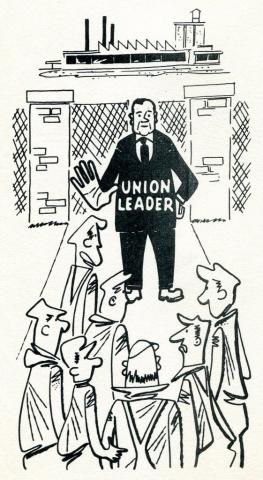 I came to Hagley on a research grant to use materials relating to my dissertation on the labor movement’s public relations activities between 1947 and 1959. I discovered by looking through Hagley’s extensive National Association of Manufacturers and U.S. Chamber of Commerce collections that labor’s outreach message was profoundly affected by the anti-labor arguments of these business trade associations.
I came to Hagley on a research grant to use materials relating to my dissertation on the labor movement’s public relations activities between 1947 and 1959. I discovered by looking through Hagley’s extensive National Association of Manufacturers and U.S. Chamber of Commerce collections that labor’s outreach message was profoundly affected by the anti-labor arguments of these business trade associations.
This document from the mid to late 1950s provides a glimpse into the content of such messages. Many documents making similar arguments are housed in the NAM and U.S. Chamber of Commerce collections at Hagley.
In 1956 or 1957, the National Association of Manufacturers (NAM) sponsored a pamphlet featuring a cartoon of a dark-clad, business-suit-wearing Union Leader halting the entry of overalled workers into an industrial plant. In the image, the workers linger at the gate, seemingly unable to act upon their desire to punch in for work in the face of the hostile Union Leader. In this case of the few against the many, the few – indeed, the one – wins out. The Union Leader hardly represents the interests of the workers that he purports to represent; instead, he works against them, presumably for his own gain. After all, no one in the picture seems to support him in his effort to shut down plant production. Here is a man who has unrivaled power, and who is using that power to prevent the progress that workingmen desire.
The drawing ran under the title “We Need a Labor Trust-Buster” as part of the NAM’s “Worth Thinking About” series of public relations pamphlets distributed to member businesses, thought leaders and the press. In the textual commentary alongside the picture, the NAM condemned monopoly power as “fundamentally wrong – economically, socially and morally.” Anti-trust laws worked effectively to curtail monopolies in big business, but “Big Labor” was not subject to this type of oversight. Instead, “power, in the hands of a few leaders of unions representing but a tenth of our population, is virtually unrestrained by existing laws,” the pamphlet argued.
A couple of union officials could decide to have their members strike, having the capacity to shut down whole industries, even against the wishes of their members. Not only was this state of affairs anti-American – contrary to the values laid out in the Declaration of Independence and the Constitution – but it also allowed union leaders to engage in corruption, unabated. The pamphlet suggested that the only solution for ending “the growing threat of a labor monopoly” was to prohibit “compulsory unionism”. If workers did not have to belong to unions as a condition of employment, then “union officers [would] recognize their real accountability to their individual members.”
Though it did not refer to the need for a “right to work,” the NAM pamphlet articulated an open shop ideology that gained more prominence with the formation of the business-supported National Right-to-Work Committee in 1955. It also came on the heels of the merger of the American Federation of Labor (AFL) and the Congress of Industrial Organizations (CIO) in 1955. Though the AFL-CIO operated as an umbrella for unions representing the majority of organized workers, not as a union in and of itself, the NAM and other business groups jumped on the merger as a demonstration of unbridled labor monopoly.
As the Congressional McClellan Committee began racketeering investigations of the Teamsters and other unions in 1957, the NAM played up the image of the union leader out of step with the interests of his workers even more. This is what labor’s public relations staffs were up against in the 1950s, and, one could argue, what they’re up against today in Wisconsin and elsewhere.
Sources
"We Need a Labor Trust-Buster" [pamphlet]. NAM Series 7, Box 139, Union Monopoly Power 1956 Folder. Hagley Museum and Library, Manuscripts and Archives Department.
Rachel Burstein is a researcher from Graduate Center, City College of New York.
